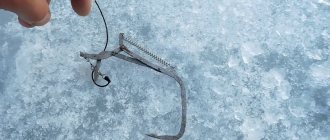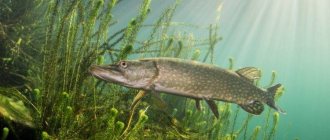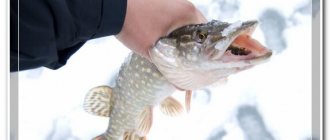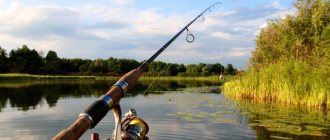Catching pike with live bait is considered one of the most exciting types of fishing. And the point is not only that sometimes a toothy predator refuses to grab artificial baits and you have to seduce it with live fish, but also the indescribable pleasure that you experience when you see a float that suddenly goes under the water, and then when you fish out a large fish that resists with incredible strength .
Tackle for catching pike with live bait
One of the main advantages of catching pike with live bait is the low cost and ease of assembling the gear. Other delights of fishing with live bait include:
- the opportunity to catch a predator in windows with vegetation;
- using gear near flooded trees and snags.
What types of live bait gear are there for fishing in open water in the autumn:
Float rod
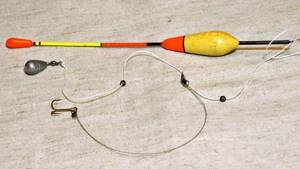
Both rods with a reel and fly rods will do. The main thing is to put a stronger fishing line and a float, the size of which will not allow the baitfish to drag it under water.
The presence of a metal leash is a must. Otherwise, the pike will simply gnaw the line and leave in an unknown direction.
The hook is a large double or treble hook, preferably with a long shank.
Usually the live bait is hooked under the dorsal fin, but sometimes, especially in the current, it should be baited by the mouth, or by passing the leash under the gill cover so that the hook comes out of the mouth.
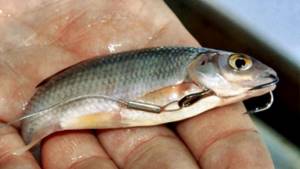
Live bait for pike
The pike, having grabbed the fish, begins to turn it with its head into its mouth. Therefore, you should not immediately hook the float after immersing the float in the water. It is better to wait 5-10 seconds and only then make a sweeping hook. Otherwise, there is no guarantee that the hook will end up in the predator’s mouth.
Do-it-yourself float rig for catching pike with live bait:
Vendors and supplies
Although poles and equipment for pike fishing are called non-sporting, these tackles are perhaps the only option for catching pike when you come to a pond with your family or friends and have absolutely no time to fish with a spinning rod or watch a float rod.
Postavushka is the simplest live bait tackle - a fishing line, a sliding sinker, one or more single or double hooks on steel leashes.
The summer girder is a little more complex in design than the supply. It has a special reel that can drop the fishing line after a pike bites. Although, there are no special differences between zherlitsy and suppliers. There are just a lot of different designs.
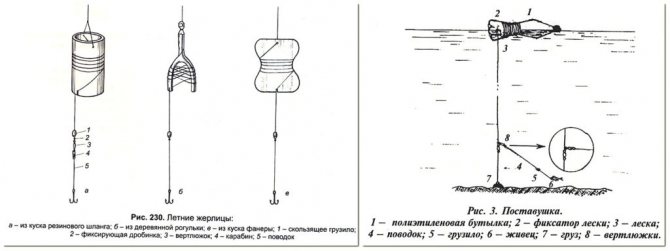
Girder and stand for pike
A fishing line is wound around a long stick with a spear at the end and stuck into the bottom of a reservoir or into the ground on the shore. The line ends with a sinker and a large hook. The bait is lowered into the water, and so that it does not float away and tangle the fishing line, it is attached to the split of the spear.
After a pike bite, the line will jump out of the split and begin to unwind from the spear. There is also a more “stripped-down” version of the zherlitsa - an ordinary children’s slingshot with a short handle, the end of which is not stuck into the ground, but is attached to a branch of a tree or bush hanging over the water.
Instead of a slingshot, a regular cylinder (a piece of hose) is used, from which the fishing line comes off like from the spool of a spinning reel. The device is attached to a plastic bottle, equipped with live bait and sent into the water with a descent corresponding to the depth. But such tackle, in principle, is more similar to mugs.
Do-it-yourself pike rigs and rigs:
Mugs
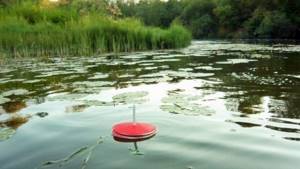
A plastic or foam circle with a fishing line wound around it, equipped with a metal leash, sinker and hook. Installed in open water.
Many fishermen use a regular plastic bottle instead of a mug. You can fish with such gear in complete calm or light wind.
They fish with circles if there is a boat, accompanying their drift with the wind or current.
Pike for mugs in the fall:
Tackle for pike
Before fishing, you need to carefully prepare by taking not one, but several fishing rods. A float rod with rings, the length of which should be no more than 4.5 meters, is ideal for pike. You can use spinning rods that are about three meters long . The reel must be powerful, inertia-free, with a reliably adjusted clutch. When using monofilament fishing line, a diameter of 0.25-0.35 mm is suitable. For braiding, thinner fishing line up to 0.12 mm is suitable.
The rod must be equipped with a tungsten or metal leader . Of the hooks, it is preferable to choose single hooks No. 2, doubles and treble hooks No. 6. To fish with live bait, you need to get a good set of floats. There are quite a lot of such floats on sale: nesting dolls, sails, balls, ordinary heavy-duty specimens, etc. It is necessary to choose a specific float in accordance with the characteristics of the fishing location.
The gear itself, as well as its components (clasps, knots, carabiners, fishing lines), must have high strength. It is important to periodically check that the clutch is adjusted correctly.
Catching pike in the fall with live bait can bring the fisherman a trophy specimen, especially if the bait is large . But, do not forget that the pike is active during this period and can damage the gear, so you need to “cut” it carefully. A real fisherman must have a fisherman for catching fry, an eland for storing them, a yawner and a special device - an extractor, with the help of which the hook is removed from the fish's mouth.
Catching pike with live bait with a float
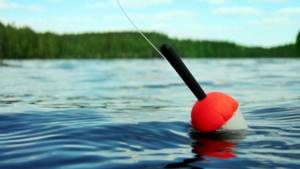
However, the most popular live bait tackle is still a fishing rod. With it you can calmly and without unnecessary hassle move along the shore of the reservoir, stopping at promising places and fishing the water area.
The rod must have a large margin of safety, since a large predator can easily break an unreliable “stick”. Its optimal length is from 4 to 6 meters. Passage rings and a reel with extra fishing line are welcome.
To make the float better visible, its upper part should be painted red, orange or black. The lower part should be dark - black, brown, green, blue. Otherwise, the pike may ignore the bait and hit the float itself.
Pike with live bait and float:
Choosing the right tactics when fishing for pike
Catching pike in the fall with live bait can begin at dawn and end at sunset . But it is interesting that the predator bites better in sunny, dry weather, but in bad weather fishing will be unsuccessful.
There is no clearly defined technique when fishing for pike. It is important to quickly react to the movement of the float and have time to hook a restless predator. And using the right tactics will certainly bring a good catch.
Initially, you need to decide on the choice of reservoir . If fishing takes place on a river with a fast current, then the equipment should be carried out near thickets of reeds, bushes, over snags, casting it far downstream. Then the tackle is reeled in, pausing for 5-7 minutes every 5-7 meters. If there were no bites in any place, then the site must be changed and the descent repeated.
In quarries and on lakes (where the water is stagnant), pike are caught using rods with a sail float. The equipment is floated downwind or actively moved, periodically stopping in each place for 15-25 minutes.
Fishing in reservoirs is characterized by active movement tactics and fishing of the most promising places.
At each location, fishing takes place in three phases of fishing:
- from the surface;
- at half-water;
- from the bottom.
Catching pike in the fall with live bait is considered the most effective compared to “quiet hunting” at other times of the year . The main thing is to be properly equipped with good equipment, bait, and tactics.
Autumn fishing with live bait
Autumn is the best time to hunt for predators. The pike ambushes among aquatic vegetation, between snags, at the exit from a hole, etc. She has fewer and fewer objects to hunt, and an ever-increasing appetite.
As the air gets colder and the water cools, peaceful fish move away from the shore, and the pike is ready to rush at anything that attracts its attention. If it stands in the place you have chosen, then rest assured that it will definitely attack the tasty and lively baitfish. You can catch pike this way all day long, as long as the float is visible.
When choosing a fishing spot, it is better to pay special attention to the following areas:
- places with vegetation - algae on the surface, thickets of reeds or cattails;
- you should not try to fish at depths of less than one meter;
- The clearer the water, the greater the chance that the predator will be able to detect prey.
Choosing a fishing spot
There are two important questions to ask: “Where do pike stand in the fall?” and the second coming from the first, “in what place should I throw the bait?” and quickly find the answer to them. A correctly chosen place promises a bite, and then, in the best case scenario, the capture of a predator. After finding a fishing spot, you need to adhere to a certain plan, which should help in a large catch.
The behavior of the pike determines where to look for it. In summer (when it is not very hot), and also for some time in September, pike prefers to stand near the shore, but as the winter period approaches, its position moves closer and closer to the depths. In September, pike can still be caught close to the shore and where it hunted in the summer, while at the end of October and November the pike no longer goes to shallow water and you shouldn’t wait for it there.
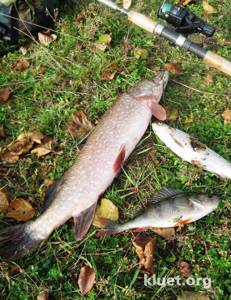
In September, pike bite on live bait in the following places:
- between reeds or reeds;
- near trees or snags that have fallen into the water;
- near thickets or other shelters.
October is considered the intermediate period between warm summer and cold winter, so at this time pikes climb closer to wintering pits (located in a smooth slope - an inclined line between one depth and another, deeper, or in small depressions of a hard/silted bottom). In these pits, pike can feed on fish, which also prepare for winter - the location of the prey also affects in which places the pike is located, that is, in those where there is food. In October there are 2 periods of time: the first half of the month, when the pike stands in the same place as in September, and the second - the pike moves deeper to the bottom. A significant cold snap means that the pike has gone to holes, slopes, cliffs and other depressions on the bottom, and that’s where you need to ambush it.
The arrival of November marks the complete departure of the pike to wintering pits, where it feeds at great depths with or without a slow current. During this period, the size of the catch increases, since the pike begins to have a strong hunger before wintering and, due to the approach of cold weather, it exclusively goes to depth. And this is another plus for fishing in the fall, since large pike swim deep. Due to the change in the location of the pike, the fishing method also changes, when it is best to catch pike with live bait from a boat in order to sail a long distance from the shore closer to deep areas.
Choice of live bait
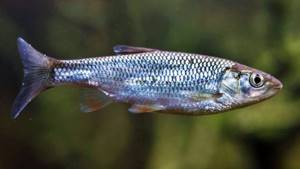
Almost any small-sized live fish is suitable for catching a hungry predator. However, it is better to give special preference to roach, bleak, small crucian carp and rudd. These species are the main ones in the pike’s diet, and when it sees its usual food, it will definitely attack it.
Less attractive to pike will be ruffe, gudgeon, perch, sleeper, and bream.
Live bait must be stored and transported from place to place in a spacious container, the water in which must be changed periodically so that the fish does not suffocate.
The float is set to such a depth that the bait swims calmly in mid-water or at the very bottom, and does not cling to the vegetation growing there. Otherwise, it will tangle the line and an offensive break may occur.
Collection of equipment
There are no particular difficulties when assembling the equipment. A special stopper for the float is put on the fishing line of the sliding equipment , and then the float itself. A sinker is attached to the resulting structure (with its sharp end to the float). To prevent the sinker from breaking the knot near the swivel, a bead is placed on the fishing line and a leash is tied. For reliability, the fishing line can be tied to a leash. At the final stage, the hook is attached.
Blind equipment is assembled in the same way, with the exception of the upper stopper, which is not provided here. Many fishing enthusiasts purchase floats that easily snap onto already assembled equipment.
Catching predatory fish with live bait in the fall
With the onset of autumn cooling, fish, in particular verkhovkas, experience a significant increase in resistance to the adverse effects of the environment. When the water temperature in the body of fish decreases, metabolic processes significantly slow down, underwater inhabitants become less sensitive to the lack of oxygen contained in the water, and the fat reserve accumulated in the summer allows them to go without food for a long time. The vitality of the verkhovkas is sometimes impressive: the fry caught in early October lived without food until December, until they were used for their intended purpose.
You can catch any predatory fish that lives in our reservoirs with the verkhovka, but due to its small size (usually 3-4 cm), in the fall live bait attracts mostly perch and medium-sized pike. Perch almost always predominates in catches; occasionally small pike are caught, and sometimes large pike bites occur, most often ending in the breakage of light tackle.
This method of fishing, like fishing with live bait in the fall, dictates a number of specific rules:
- Casting should be done smoothly; before the live bait falls onto the water, the bait should be slightly slowed down with the rod, softening its impact on the surface as much as possible.
- When removing the fry from the eland, use a small aquarium net, protecting the remaining live bait from injury.
- Often during casting, live bait jumps off the hook of the jig. Unreasonably high losses can be avoided by placing a stopper cut from an ordinary plastic bag on the hook.
